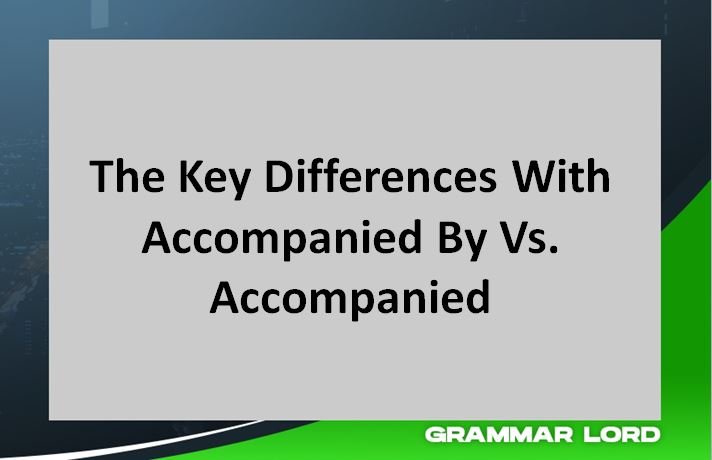Are you struggling to use “accompanied by” and “accompanied with” correctly? This comprehensive guide offers clear explanations, examples, and synonyms to improve your grammar and writing.
READ ALSO: What Is The Difference Between Aside And Beside?
Contents
- 1 What Does Accompanied By Mean?
- 2 What Does Accompanied With Mean?
- 3 Accompanied By Vs. Accompanied With: Key Differences
- 4 Accompanied By And Accompanied With Synonyms
What Does Accompanied By Mean?
Accompanied by is a prepositional phrase used to indicate that someone or something is in the company of another person or thing.
It suggests a relationship of togetherness, association, or dependence. When another accompanies something, the two are connected or linked somehow.
Here’s how you can use this term in a sentence:
-
A guest is often accompanied by a host.
-
A meal might be accompanied by a specific beverage.
-
A storm is usually accompanied by thunder and lightning.
In these examples, the person, beverage, or weather phenomenon is present with the other element, creating a sense of partnership or correlation.
What Does Accompanied With Mean?
Accompanied with is a prepositional phrase that signifies something is present or included alongside another thing.
Unlike “accompanied by,” which often implies a closer relationship or dependence, “accompanied with” suggests a more casual or incidental association.
It indicates that two things exist together, but without necessarily implying a strong connection between them.
Let’s take for Instance:
- A meal might be accompanied with a side dish.
- A gift can be accompanied with a card.
- A presentation is often accompanied with slides.
In these cases, the side dish, card, or slides complement the main item but are not essential to it. They simply exist together.
Accompanied By Vs. Accompanied With: Key Differences
Accompanied by suggests a closer relationship or dependence. It means that one thing is essential to the other.
For instance, “The president was accompanied by his security detail.” Here, the security detail is important for the president’s safety.
It’s like two people going together on a journey, where one needs the other. Also, “accompanied with” tells a more casual or incidental connection. It indicates two things exist together, but one isn’t necessary for the other.
For example,
- “The pizza was accompanied with garlic bread.” The garlic bread is an extra, not a requirement.
Let’s look at more examples:
Accompanied by:
-
A bride is accompanied by her bridesmaids.
-
A storm is accompanied by thunder and lightning.
-
A fine wine is accompanied by a delicious cheese.
Accompanied with:
-
A gift is accompanied with a card. (optional addition)
-
The meal was accompanied with a side salad. (optional accompaniment)
-
The presentation was accompanied with slides.
READ ALSO: Difference Between “Atleast” And “At Least”
Accompanied By And Accompanied With Synonyms
Synonyms For “Accompanied By”
- Joined by
- Attended by
- In company with
- Together with
- Escorted by
- Guided by
- Followed by
- Convoyed by
- Defended by
- Guarded by
Synonyms For “Accompanied With”
- Paired with
- Combined with
- Coupled with
- Along with
- Associated with
- Linked with
- Joined with
- Together with
- Included with
- Bundled with
READ ALSO: Inactivate And Deactivate: The Key Differences
FAQs About Accompanied By Vs Accompanied With: The Key Differences
What Is The Difference Between “Accompanied by” And “Accompanied with”?
Accompanied by indicates a close relationship or dependence, while accompanied with suggests a casual association.
When Should I Use “Accompanied by”?
Use “accompanied by” when one person or thing is essential to another.
When Should I Use “Accompanied with”?
Use “accompanied with” when something is added to something else but isn’t necessary.
Can I Use “Accompanied by” And “Accompanied with” Interchangeably?
No, they have different meanings and should not be used interchangeably.

